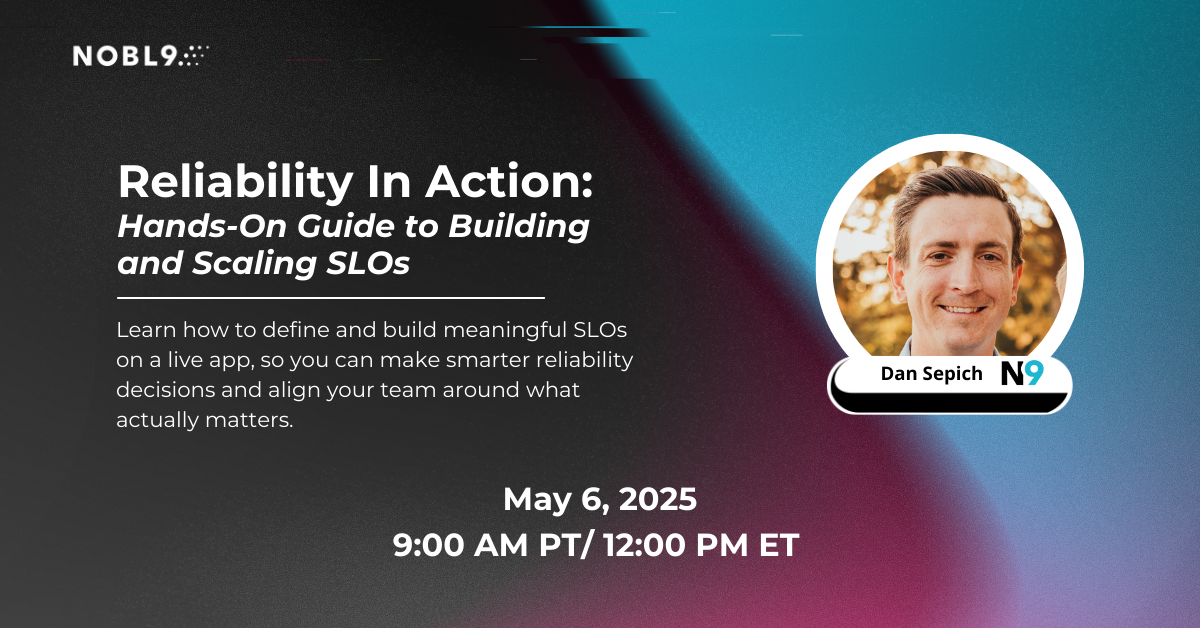More by Erza Zylfijaj:
Driving Cultural Shift Towards Site Reliability Engineering SLOs Gone Wild: Surviving Service Level Chaos with Advanced Strategies Nobl9 Named Finalist for CRN 2024 Tech Innovator Award in Application Performance and Observability Strategies and Business Benefits of Implementing Service Level Objectives (SLOs) Are You Ready For #SLOconf? How To Simplify Producing Pre-Recorded Talks with the Speaker Buddy System Introducing A New Way of Creating, Managing, and Sharing Reports Navigating Service Level Objectives and Graceful Degradation: A Webinar with Stanza, Google, & Pagerduty After SLOConf: A Conversation About Reliability After SLOconf: Steve McGhee Talks Math| Author: Erza Zylfijaj
Avg. reading time: 4 minutes
 Friends, SREs, countrypeople, lend me your ears. I come to bury MTTR, not to praise it.
Friends, SREs, countrypeople, lend me your ears. I come to bury MTTR, not to praise it.
In the world of IT and software engineering, the Mean Time to Recovery (MTTR) has long been a key performance indicator (KPI). It's simple in concept—how long does it take to fix something when it breaks? However, in a rapidly evolving technological landscape, is MTTR still relevant? Or is it time to move beyond this reactive metric and adopt a more proactive approach?
In this post I want to explore the shifting role of MTTR in modern enterprises and why Service Level Objectives (SLOs) are becoming the new standard for ensuring reliability. We’ll look at the limitations of MTTR, the benefits of SLOs, and how Nobl9 is leading the charge towards a more reliable future for your business.
The Traditional Role of MTTR
What is MTTR?
MTTR, or Mean Time to Recovery (or Repair; it is a legacy metric that grew out of hardware monitoring), measures the average time it takes to identify, respond to, and fix a ticketed issue. In theory, it’s a useful metric for understanding the efficiency of your incident response process - high MTTR should indicate slow recovery times, which can lead to prolonged service interruptions and dissatisfied customers, and low MTTR should indicate your SRE team is top-notch at fixing what's broken. However, does it work?
MTTR in Incident Management
Traditionally, MTTR has been viewed as a critical organizational metric for incident management. It helps organizations understand their ability to respond and recover from failures. A lower MTTR - once again, in theory - signifies quicker recovery times and thus, better incident management. However, this focus on recovery time alone can be shortsighted, and the math behind MTTR metrics does not typically reflect actual response and recovery capabilities.
The Limitations of MTTR
In practice, MTTR metrics are often woefully inaccurate. Many variables impact MTTR: number of small tickets pushed into a queue; ratio of small tickets to actual incidents and outages; how you define start and stop times; how good your data quality is, and so on. This tends to be the divide between MTTR in theory and MTTR in practice - if you respond to hundreds of small, non-user-impacting tickets quickly but have one outage that takes a day to resolve, your MTTR will be badly skewed towards looking great, even though the one time your reliability actually impacted users they were unable to engage with your product or service for a reasonably long time.
Further, even if MTTR were set up to absorb any statistical or real-world impediments to its accuracy, it doesn’t offer a complete picture of system reliability. It's a reactive metric, kicking into action only after an incident has occurred - the damage is already done, but how fast can we recover from it. In today’s digital age, waiting for things to break before fixing them is not an ideal strategy.
MTTR vs. SLOs
MTTR as an Incident Response KPI
MTTR is not easily discarded; it still has a place in incident response, as it is a legacy metric that is still entrenched in many organizations. It's a useful metric for socializing in response to outages among shareholders, media and customers. However, MTTR must always at least be taken with a large grain of salt internally by organizations, in particular by SREs. Recognizing its flaws as a measurement naturally leads to a desire to find a more reliable, less reactive way of defining reliability.
SLOs for Reliability
SLOs by comparison offer a more comprehensive approach to ensuring system reliability. By setting clear performance targets, organizations can proactively manage their systems and avoid many of the issues that would otherwise result in outages. SLOs encourage a culture of continuous improvement, where the goal is to maintain high performance rather than simply reacting to failures.
Combining MTTR and SLOs
The most effective approach combines both MTTR and SLOs. While SLOs provide a proactive framework for maintaining high reliability, MTTR provides organizations with PR and IR ammunition to leverage in the wake of an incident. If tuned absolutely correctly, MTTR can serve as a reasonable reactive metric; however, it will take a lot of expert effort to take away or account for the measurement's inherent flaws.
It is worth noting for SREs, you will likely still be judged on legacy metrics, including MTTR and MTTD. SLOs, in addition to giving you improved reliability metrics and insights about how your reliability efforts are affecting the user experience, will also almost assuredly have the side effect of improving these legacy metrics. A SLO-driven reliability strategy will improve your reliability. Encouraging organizational buy-in on modern SRE strategies is a hard change management challenge; if, however, your legacy metrics improve as a result of your own SLO-driven reliability efforts, it becomes much easier.
🚀 Move Beyond MTTR – Embrace SLOs
MTTR is a thing of the past. Service-Level Objectives (SLOs) provide a proactive and customer-centric approach to reliability. Discover how Nobl9 helps teams define, track, and optimize SLOs for better service performance.
🎯 Book a DemoThe Future of Reliability with Nobl9
Proactive Reliability with Nobl9
Here at Nobl9 we are at the forefront of this shift toward proactive reliability. Our platform enables organizations to define, measure, and manage SLOs, providing a clear picture of system performance. By using Nobl9, companies can transition from a reactive to a proactive approach, ensuring higher reliability and customer satisfaction.
How to Get Started
If you’re interested in moving beyond MTTR and adopting a more proactive approach to reliability, start by defining your SLOs. Identify the key performance indicators that matter most to your business and set achievable targets. Tools like Nobl9 can help you manage and monitor these objectives, ensuring that you maintain high reliability.
While MTTR has long been a staple of incident management, it’s time to recognize its limitations. In a world where downtime can have severe consequences, a reactive approach is no longer sufficient. By adopting SLOs and transitioning to a proactive strategy, organizations can achieve higher reliability and better customer satisfaction.
If you’re ready to take your reliability to the next level, consider exploring how SLOs can benefit your organization. Nobl9 make it easier than ever to manage and meet your reliability goals.









.png?width=1200&height=628&name=Building%20Reliable%20E-commerce%20Experiences%20(24).png)
.png?width=1200&height=628&name=Building%20Reliable%20E-commerce%20Experiences%20(22).png)
.png?width=1200&height=628&name=Building%20Reliable%20E-commerce%20Experiences%20(19).png)






Do you want to add something? Leave a comment